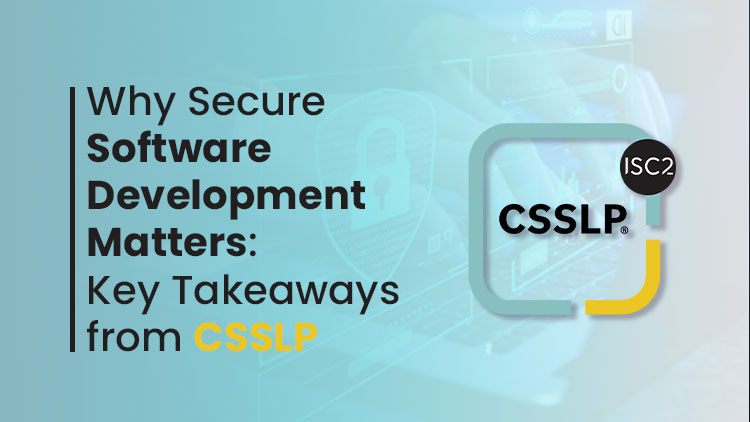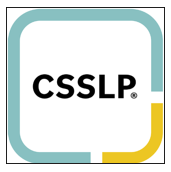
Why Secure Software Development Matters: Key Takeaways from CSSLP

Why Secure Software Development Matters: Key Takeaways from CSSLP
Introduction
In today’s digital landscape, security is no longer an afterthought—it is an integral part of the software development lifecycle (SDLC). Cyber threats continue to evolve, with attackers constantly finding new ways to exploit vulnerabilities. Organizations must take a proactive approach to ensure that their software is resilient to cyber risks.
This is where the Certified Secure Software Lifecycle Professional (CSSLP) certification becomes invaluable. CSSLP equips developers, architects, and security professionals with the knowledge and skills to integrate security practices throughout the SDLC. It emphasizes secure coding, risk management, and best practices that mitigate software vulnerabilities.
Strengthen your secure software development skills with VERSAtile Reads’ focused exam prep resources. Access structured exam cram notes and practice questions designed to help you master CSSLP and advance your cybersecurity knowledge. Start your certification journey today.
Understanding Secure Software Development
Secure software development is a methodology that integrates security at every stage of the software development lifecycle. This proactive approach helps in identifying and mitigating vulnerabilities before software deployment. Traditionally, security was addressed in the later stages of development, often during testing. However, this reactive approach leads to increased costs and risks. Secure software development ensures that security is embedded into the design, development, testing, and deployment phases.
The key benefits of secure software development include:
- Minimized security risks: Reduces vulnerabilities and potential breaches.
- Regulatory compliance: Meets security standards such as GDPR, HIPAA, and PCI DSS.
- Enhanced reputation: Builds trust with customers by ensuring data privacy.
- Cost savings: Prevents costly post-deployment fixes and legal penalties.
What is CSSLP?
The Certified Secure Software Lifecycle Professional (CSSLP) is a globally recognized certification offered by (ISC)² that validates a professional’s expertise in incorporating security practices into each phase of the software development lifecycle (SDLC). The CSSLP credential demonstrates a strong understanding of secure software design, development, testing, and deployment, ensuring that security is integrated into every stage of the software creation process. Professionals who earn the CSSLP certification are equipped to identify and mitigate security vulnerabilities in software, manage risk, and ensure compliance with regulatory standards. The certification covers key domains such as secure software concepts, requirements, design, implementation, testing, deployment, and maintenance, making it an essential qualification for software developers, engineers, architects, and other IT professionals committed to producing secure and resilient software.

Key Takeaways from CSSLP
CSSLP is a globally recognized certification from (ISC)² that validates expertise in secure software development. It follows a comprehensive framework that ensures security is integrated throughout the SDLC. Here are some essential takeaways from CSSLP:
1. Security Integration Across SDLC
CSSLP emphasizes embedding security in every SDLC phase:
- Requirements Gathering: Identifying security needs before development begins.
- Design & Architecture: Implementing secure design principles such as least privilege and defense-in-depth.
- Development: Writing secure code and preventing vulnerabilities such as SQL injection and buffer overflows.
- Testing: Conducting static and dynamic security testing to identify flaws.
- Deployment & Maintenance: Ensuring continuous monitoring, patch management, and secure updates.
2. Secure Coding Practices
A crucial aspect of CSSLP is promoting secure coding best practices to minimize security flaws. Some essential practices include:
- Input validation: Preventing injection attacks by validating user input.
- Secure authentication: Using multi-factor authentication (MFA) to enhance security.
- Error handling: Avoiding exposure of sensitive information through error messages.
- Secure session management: Protecting user sessions from hijacking attacks.
3. Threat Modeling and Risk Assessment
CSSLP teaches professionals how to identify, assess, and mitigate security risks through threat modeling. This involves:
- Identifying potential threats: Using frameworks like STRIDE or DREAD.
- Assessing risk levels: Determining the likelihood and impact of threats.
- Implementing countermeasures: Using encryption, access controls, and other security mechanisms.
- Threat modeling helps teams understand attack vectors and proactively secure software against threats.
4. Compliance and Regulatory Considerations
Organizations must adhere to various security regulations and standards, such as:
- GDPR (General Data Protection Regulation)
- HIPAA (Health Insurance Portability and Accountability Act)
- PCI DSS (Payment Card Industry Data Security Standard)
CSSLP equips professionals with the knowledge to ensure software compliance with industry regulations, protecting both users and businesses from legal and financial repercussions.
5. Continuous Security Monitoring and Incident Response
Cybersecurity threats do not end after deployment. CSSLP highlights the importance of continuous security monitoring to detect and mitigate attacks in real time. This includes:
- Implementing intrusion detection systems (IDS).
- Conducting regular security audits and penetration testing.
- Setting up automated alerts for suspicious activities.
- Having an incident response plan to quickly address breaches.
The Business Impact of Secure Software Development
1. Preventing Costly Breaches
Cyberattacks can lead to massive financial losses. According to IBM’s Cost of a Data Breach Report, the average data breach cost in 2023 was $4.45 million. Investing in secure software development can prevent security breaches and save millions in potential damages.
2. Strengthening Customer Trust
Consumers are more aware of data privacy concerns. Secure applications ensure customer trust and brand reputation, leading to better user retention and business growth.
3. Enhancing Competitive Advantage
Organizations that prioritize security gain a competitive edge in the market. Compliance with security regulations and best practices makes software products more attractive to enterprise clients and users.
4. Reducing Post-Deployment Fixes
Fixing security issues post-deployment is far more expensive and time-consuming than addressing them during development. Secure development practices help reduce technical debt and improve software reliability.
Summary
Security should be embedded in every phase of the software development lifecycle (SDLC) to minimize vulnerabilities and ensure robust protection. Implementing secure coding practices, like input validation and secure authentication, reduces the risk of exploitation. Threat modeling and risk assessment help organizations proactively identify and address potential security threats before they become critical issues. Compliance with industry regulations, such as GDPR and HIPAA, ensures legal protection and safeguards user data. Additionally, continuous security monitoring strengthens defenses by detecting and mitigating evolving cyber threats in real time.
Conclusion
Secure software development is no longer optional—it is a necessity. The CSSLP framework provides professionals with a structured approach to integrate security at every stage of the SDLC. From secure coding to compliance and continuous monitoring, CSSLP ensures that software is resilient against cyber threats.
Organizations and developers who adopt secure development practices not only protect their applications from attacks but also gain trust, reduce costs, and comply with industry standards. By prioritizing security, businesses can build reliable and future-proof software solutions that stand the test of time.
FAQs
1. What is the importance of CSSLP in software development?
CSSLP is a certification that ensures security best practices are applied throughout the software development lifecycle. It helps professionals build secure applications, reduce vulnerabilities, and comply with industry regulations.
2. How does secure software development benefit businesses?
Secure software development prevents costly breaches, enhances customer trust, reduces post-deployment fixes, and strengthens an organization’s competitive advantage in the market.
3. What are the key principles of secure software development?
The key principles include security integration across SDLC, secure coding, risk assessment, compliance, and continuous security monitoring to proactively protect software applications.
- Published Date:



